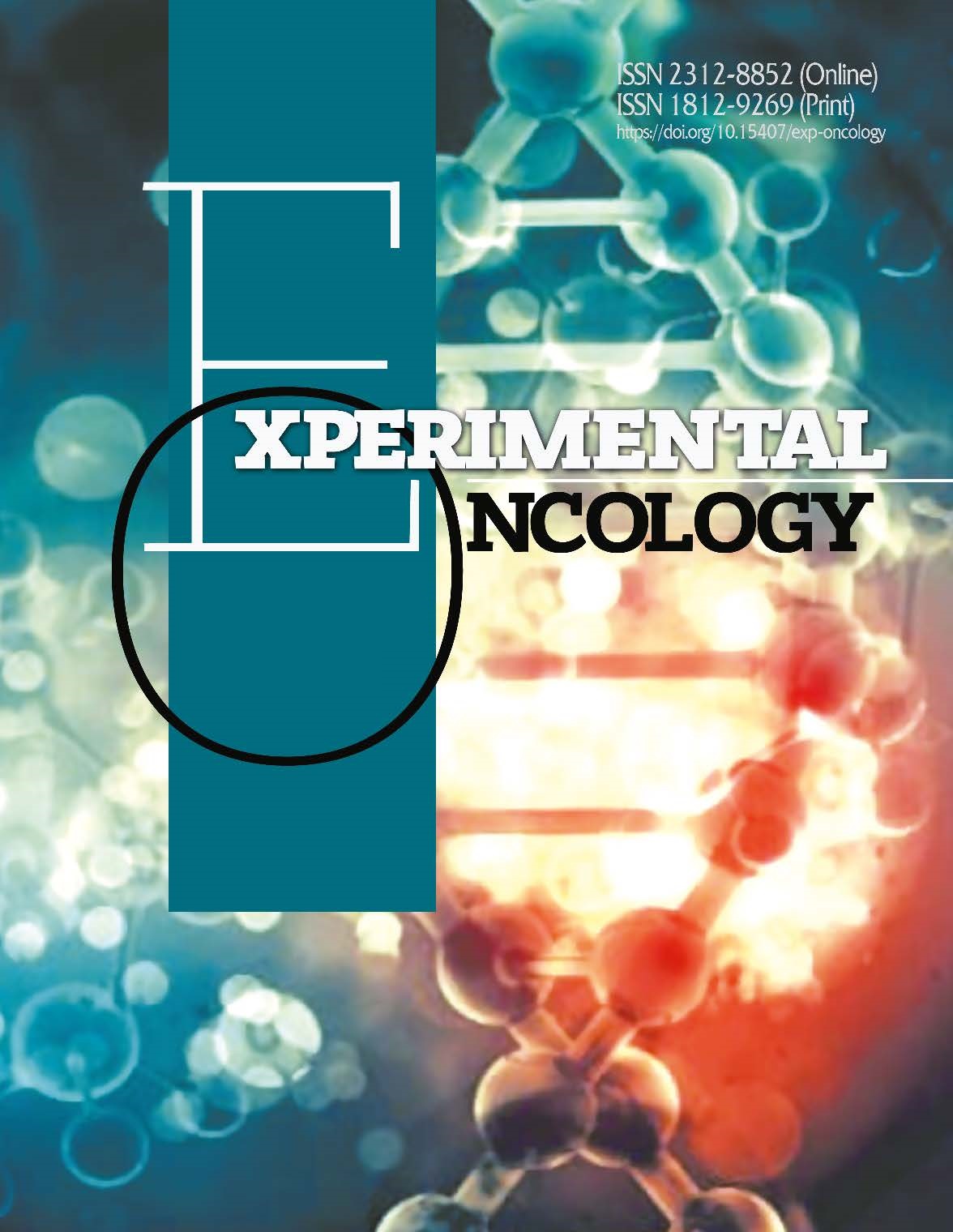ЕКСПРЕСІЯ ГЕНІВ SPP1 ТА SPARC У ПУХЛИННІЙ ТКАНИНІ ХВОРИХ НА РАК МОЛОЧНОЇ ЗАЛОЗИ
DOI:
https://doi.org/10.15407/exp-oncology.2024.01.013Ключові слова:
рак молочної залози, остеопонтин, остеонектин, прогнозування перебігу, виживаністьАнотація
Стан питання. Рак молочної залози (РМЗ) є однією із найпоширеніших онкопатологій у жінок як в Україні, так і у світі, що визначає необхідність пошуку нових діагностичних та прогностичних маркерів. У цьому аспекті актуальним є вивчення матрицелюлярних протеїнів, зокрема остеопонтину (OPN) та остеонектину (ON). Мета роботи. Дослідити показники експресії SPP1 та SPARC на рівні мРНК та білка у тканині РМЗ та встановити їх зв’язок з основними клінікопатологічними характеристиками пухлинного процесу і показниками вижива ності хворих. Матеріали та методи. Робота базується на аналізі результатів обстеження та лікування 60 хво рих на РМЗ ІІ—ІІІ стадії та 15 пацієнток із фіброаденомами молочної залози, які знаходились на лікуванні у Київському міському клінічному онкологічному центрі протягом 2015—2019 рр. Рівні мРНК SPP1 та SPARC визначали методом ПЛР в реальному часі. Дослідження експресії SPP1 та SPARC на рівні білка проводили іму ногістохімічним методом. Результати. Встановлено, що тканина злоякісних новоутворень молочної залози ха рактеризується у 3,5 (р < 0,05) та в 7,4 (р < 0,05) разів меншими рівнями відповідно мРНК SPP1 та SPARC у по рівнянні з тканиною доброякісних новоутворень. Показано, що показники експресії OРN та ON у тканині РМЗ є відповідно в 1,6 (р < 0,05) та 5,6 (р < 0,05) разів більшими порівняно із тканиною фіброаденом. Аналіз зв’язку між експресією SPP1 та SPARC на рівні білка та мРНК у тканині РМЗ та основними клінікопатологічними характеристиками пухлинного процесу встановив існування залежності з наявністю метастазів в реґіонарних лімфатичних вузлах, ступенем диференціювання та молекулярним підтипом новоутворень. Виявлено, що ви сокі рівні експресії SPP1 та OPN у тканині РМЗ асоціюються із гіршими показниками виживаності хворих. Висновок. Отримані результати свідчать про перспективність використання показників експресії SPP1 та SPARC у тканині РМЗ для оцінки агресивності перебігу пухлинного процесу та оптимізації тактики лікування хворих.
Посилання
Sung H, Ferlay J, Siegel L, et al. Global Cancer Statistics 2020: GLOBOCAN estimates of incidence and morta lity worldwide for 36 cancers in 185 countries. CA: a cancer journal for clinicians. 2021;71(3):209-249. https://doi. org/10.3322/caac.21660
Brook N, Brook E, Dharmarajan A, et al. Breast cancer bone metastases: pathogenesis and therapeutic targets.
Int J Biochem Cell Biol. 2018;96:63-78. https://doi.org/10.1016/j.biocel.2018.01.003
Pein M, Oskarsson T. Microenvironment in metastasis: roadblocks and supportive niches. Am J Physiol Cell Physiol. 2015;309(10):627-638. https://doi.org/10.1152/ajpcell.00145.2015
Oskarsson T. Extracellular matrix components in breast cancer progression and metastasis. Breast. 2013;22(2):66-72. https://doi.org/10.1016/j.breast.2013.07.012
Lepucki A, Orlińska K, Mielczarek-Palacz A, et al. The role of extracellular matrix proteins in breast cancer. J Clin Med. 2022;11(5):1250. https://doi.org/10.3390/jcm11051250
Xu Y, Zhang Y, Lu F, et al. Prognostic value of osteopontin expression in breast cancer: A meta-analysis. Mol Clin Oncol. 2015;3(2):357-362. https://doi.org/10.3892/mco.2014.480
Delany A. M. Matricellular proteins osteopontin and osteonectin/SPARC in pancreatic carcinoma. Cancer Biol Ther. 2010;10(1):65-67. https://doi.org/10.4161/cbt.10.1.12452
Zhao H, Chen Q, Alam A, et al. The role of osteopontin in the progression of solid organ tumour. Cell Death Dis. 2018;9(3):356. https://doi.org/10.1038/s41419-018-0391-6
Rodrigues R, Teixeira A, Schmitt L, et al. The role of osteopontin in tumor progression and metastasis in breast can cer. Cancer Epidemiol Biomarkers Prev. 2007;16(6):1087-1097. https://doi.org/10.1158/10559965.EPI-06-1008
Icer MA, Gezmen-Karadag M. The multiple functions and mechanisms of osteopontin. Clin Biochem. 2018;59:1724. https://doi.org/10.1016/j.clinbiochem.2018.07.003
Young MF, Kerr JM, Ibaraki K, et al. Structure, expression, and regulation of the major noncollagenous matrix pro teins of bone. Clin Orthop Relat Res. 1992;281:275-294. PMID: 1499220
Tuck AB, Chambers AF. The role of osteopontin in breast cancer: clinical and experimental studies. J Mammary Gland Biol Neoplasia. 2001;6(4):419-429. https://doi.org/10.1023/a:1014734930781
Bramwell VH, Tuck AB, Chapman JA, et al. Assessment of osteopontin in early breast cancer: correlative study in a randomised clinical trial. Breast Cancer Res. 2014;16(1):R8. https://doi.org/10.1186/bcr3600
Shi S, Ma HY, Han XY, et al. Prognostic significance of SPARC expression in breast cancer: A meta-analysis and bio informatics analysis. BioMed Res Int. 2022;8600419. https://doi.org/10.1155/2022/8600419
Lindner JL, Loibl S, Denkert C, et al. Expression of secreted protein acidic and rich in cysteine (SPARC) in breast cancer and response to neoadjuvant chemotherapy. Ann Oncol. 2015;26(1):95-100. https://doi.org/10.1093/annonc/ mdu487
Bergamaschi A, Tagliabue E, Sørlie T, et al. Extracellular matrix signature identifies breast cancer subgroups with different clinical outcome. J Pathol. 2008;214(3):357-367. https://doi.org/10.1002/path.2278
Ma J, Gao S, Xie X, et al. SPARC inhibits breast cancer bone metastasis and may be a clinical therapeutic target. Oncol Lett. 2017;14(5):5876-5882. https://doi.org/10.3892/ol.2017.6925
Zhang JD, Ruschhaupt M, Biczok R. ddCt method for qRT–PCR data analysis. Citeseer. 2013;48(4):346-356.
McClelland RA, Wilson D, Leake R, et al. A multicentre study into the reliability of steroid receptor immunocytochemical assay quantification. British Quality Control Group. Eur J Cancer. 1991;27(6):711-715. https://doi. org/10.1016/0277-5379(91)90171-9
Di Gregorio J, Di Giuseppe L, Terreri S, et al. Protein stability regulation in osteosarcoma: the ubiquitin-like modifications and glycosylation as mediators of tumor growth and as targets for therapy. Cells. 2024; 13(6):537. https://doi. org/10.3390/cells13060537
Pang H, Lu H, Song H, et al. Prognostic values of osteopontin-c, E-cadherin and β-catenin in breast cancer. Cancer Epidemiol. 2013;37(6):985-992. https://doi.org/10.1016/j.canep.2013.08.005
Allan AL, George R, Vantyghem SA, et al. Role of the integrinbinding protein osteopontin in lymphatic metastasis of breast cancer. Am J Pathol. 2006;169(1):233246. https://doi.org/10.2353/ajpath.2006.051152
Wang X, ChaoL, Ma G, Chen L, et al. Increased expression of osteopontin in patients with triplenegative breast cancer. Eur J Clin Invest. 2008;38(6):438-446. https://doi.org/10.1111/j.1365-2362.2008.01956.x
Niedolistek M, Fudalej MM, Sobiborowicz A, et al. Immunohistochemical evaluation of osteopontin expression in triple-negative breast cancer. AMS. 2020;20(2). https://doi.org/10.5114/aoms.2020.93695
Zadvornyi T, Lukianova N, Borikun T, et al. Еxpression of osteopontin and osteonectin in breast and prostate cancer cells with different sensitivity to doxorubicin. Exp Oncol. 2022;44(2):107-112. https://doi.org/10.32471/exponcology.2312-8852.vol-44-no-2.17886
Bie T, Zhang X. Higher expression of SPP1 predicts poorer survival outcomes in head and neck cancer. J Immunol Res. 2021;8569575. https://doi.org/10.1155/2021/8569575
Xu C, Sun L, Jiang C, et al. SPP1, analyzed by bioinformatics methods, promotes the metastasis in colorectal cancer by activating EMT pathway. Biomed Pharmacother. 2017;91:1167-1177. https://doi.org/10.1016/j.biopha.2017.05.056
Ortiz-Martínez F, Perez-Balaguer A, Ciprián D, et al. Association of increased osteopontin and splice variant-c mRNA expression with HER2 and triple-negative/basal-like breast carcinomas subtypes and recurrence. Hum Pathol. 2014;45(3):504-512. https://doi.org/10.1016/j.humpath.2013.10.015
Watkins G, DouglasJones A, Bryce R, et al. Increased levels of SPARC (osteonectin) in human breast cancer tissues and its association with clinical outcomes. Prostaglandins Leukot Essent Fatty Acids. 2005;72(4):267272. https://doi.org/10.1016/j.plefa.2004.12.003
Shi S, Ma HY, Han XY, et al. Prognostic significance of SPARC expression in breast cancer: a meta-analysis and bio informatics analysis. BioMed Res Int. 2022;8600419. https://doi.org/10.1155/2022/8600419
Alcaraz LB, Mallavialle A, Mollevi C, et al. SPARC in cancer-associated fibroblasts is an independent poor prognostic factor in non-metastatic triple-negative breast cancer and exhibits pro-tumor activity. Int J Cancer. 2023;152(6):1243-1258. https://doi.org/10.1002/ijc.34345
Azim HA Jr, Singhal S, Ignatiadis M, et al. Association between SPARC mRNA expression, prognosis and response to neoadjuvant chemotherapy in early breast cancer: a pooled in-silico analysis. PloS One. 2013;8(4):e62451. https://doi.org/10.1371/journal.pone.0062451
##submission.downloads##
Опубліковано
Як цитувати
Номер
Розділ
Ліцензія
Авторське право (c) 2024 Експериментальна онкологія

Ця робота ліцензується відповідно до Creative Commons Attribution-NonCommercial 4.0 International License.



